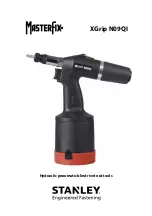
TM-VE414/415MC_57
REV_D
TM-VE414/415MC
/ Operating and Maintenance Instructions Manual
EXPLANATION OF CRITICAL ROLL GROOVE DIMENSIONS FOR
ADVANCED GROOVE SYSTEM (AGS) PRODUCTS (CONTINUED)
“A” Dimension –
The “A” dimension, or the distance from the pipe end to the groove, identifies the
gasket seating area. This area shall be free from indentations, projections (including weld seams),
and roll marks from the pipe end to the groove to ensure a leak-tight seal. All foreign material, such
as loose paint, scale, oil, grease, chips, rust, and dirt shall be removed.
“B” Dimension –
The “B” dimension, or groove width, controls expansion, contraction, and angular
deflection of flexible couplings by the distance it is located from the pipe and its width in relation
to the coupling housings’ “key” width. The bottom of the groove shall be free of all foreign material,
such as dirt, chips, rust, and scale that may interfere with proper coupling assembly. The corners at
the bottom of the groove shall be radiused R .094/R 2.39. The Groove Width “B” dimension will be
achieved with properly maintained Victaulic tools that are equipped with Victaulic AGS (RW or RWQ)
roll sets for carbon steel and standard-wall stainless steel pipe or Victaulic AGS (RWX or RWQX)
specifically for light-wall stainless steel pipe.
“C” Dimension –
The “C” dimension is the average diameter at the base of the groove. This
dimension shall be within the diameter’s tolerance and concentric with the OD for proper coupling
fit. The groove shall be of uniform depth for the entire pipe circumference. Victaulic RW roll sets
shall be used for carbon steel and standard-wall stainless steel pipe. Victaulic RWX roll sets shall be
used for light-wall stainless steel pipe.
“D” Dimension –
The “D” dimension is the normal depth of the groove and is a reference for a
“trial groove” only. Variations in pipe OD affect this dimension and it shall be altered, if necessary,
to keep the “C” dimension within tolerance. The groove diameter shall conform to the “C”
dimension described above.
“F” Dimension –
Maximum allowable pipe-end flare diameter is measured at the extreme pipe-end
diameter.
NOTE:
This applies to average (pi tape) and single-point readings.
Minimum Nominal Wall Thickness –
The minimum nominal wall thickness is the lightest grade
of pipe that is suitable for cut or roll grooving. Pipe that is less than the minimum nominal wall
thickness for cut grooving may be suitable for roll grooving or adapted for Victaulic AGS couplings
by using AGS Vic-Ring
®
Adapters. AGS Vic-Ring Adapters can be used in the following situations
(contact Victaulic for details):
• When pipe is less than the minimum nominal wall thickness suitable for roll grooving
• When pipe outside diameter is too large to roll or cut groove
• When pipe is used in abrasive services
For light-wall carbon steel pipe being grooved to AGS specifications
(in accordance with EN 10217 or ASTM A-53):
14-inch/355.6-mm minimum nominal wall thickness is 0.220 inch/5.6 mm
16–24-inch/406.4–610-mm minimum nominal wall thickness is 0.250 inch/6.3 mm
For standard-wall carbon steel pipe being grooved to AGS specifications
(in accordance with EN 10217 or ASTM A-53):
14-inch/355.6-mm minimum nominal wall thickness is 0.315 inch/8.0 mm
16-inch/406.4-mm minimum nominal wall thickness is 0.346 inch/8.8 mm
18–36-inch/457–914-mm minimum nominal wall thickness is 0.375 inch/9.5 mm
Summary of Contents for VE414MC
Page 2: ......
Page 47: ...This page intentionally blank...
Page 59: ...This page intentionally blank...








































